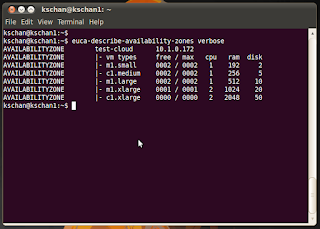Observation-1
---
If you write to the root filesys of vm instance, the wrote data will not be saved to WSC when the instance is terminated. But, euca2ools provides "euca-bundle-vol" utility to "upload" a local filesys of an instance to WSC. That's to say ... u have to create another root filesys copy on WSC to save your write.
Observation-2
---
If a volume attached to 1 vm instance, it cannot be attached to other at the same moment unless it is detached. So, if you wanna host a shared data pool on eucalyptus, you have to use several vm instances to host nosqldb like mongodb or cassandra. And each of these instances has dedicated volume attached. Save your data via NoSQL :)
Observation-3
---
With eucalyptus managed network setting, network access to vm instances is controlled by security group. A security group will maintain a set of in-bound rules likes below:
PERMISSION admin default ALLOWS tcp 22 22 FROM CIDR 144.214.0.0/16
PERMISSION admin default ALLOWS tcp 22 22 FROM CIDR 10.2.0.0/16
PERMISSION admin default ALLOWS icmp 0 0 FROM CIDR 10.2.0.0/16
PERMISSION admin default ALLOWS icmp 0 0 FROM CIDR 144.214.0.0/16
For out-bound rules, setup firewall within the vm instances. Eucalyptus does not manage that.
Observation-4
---
As with eucalyptus managed private network, vm instances may use private IP address. To access them, you have to be connected to an instance at first and use the private IP address as locator. That's to say, you need to have at least 1 public IP address that the outside world can connect to an instance.
If you configured to use vlan enabled managed network, vm instances of different security group will have different subnet assigned. The virtual network isolation is done by this feature. To allow two subnet to communicate, add in-bound rules to the security group.
(But i'm still trying the network config, may have update on this later)
Personal opinion in managing the cloud with client tool
---
Hybridfox is great! But euca2ools with just cli is simple and even more great. I personally prefer euca2ools.
What's next??
---
Go ahead to host private AppEngine - appsacle. But, don't know whether i can get it managed with such a limited "availability" zone






